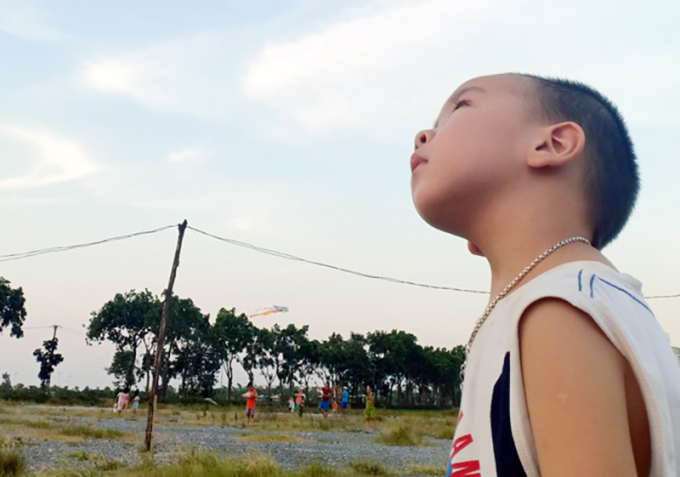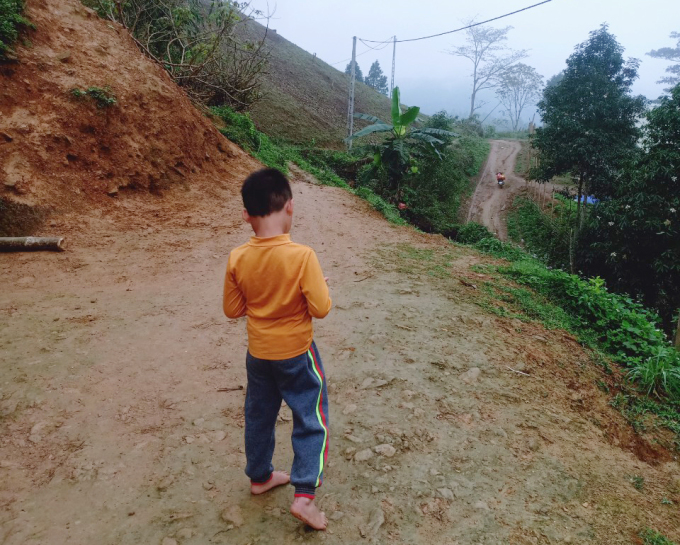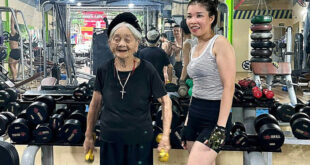Giang A Pao took his son, who would keep smacking his head on the ground when happy, to the Vietnam National Children’s Hospital to find out the cause.
In March 2021, the 33-year-old in the northern Bac Kan Province heard the term autism for the very first time.
“Then I started to know why my son was acting strangely,” he says.
Cam Thi Huyen in the northwestern Son La Province was scared of her autistic son’s unpredictable actions.
One time, when two years old, he suddenly ran into the middle of the road, forcing the driver of a container truck to slam hard on the brake almost causing the vehicle to flip over. Thankfully, the vehicle stopped in time and the boy was unharmed.
 |
|
Truong, Cam Thi Huyen’s four-year-old son, in Hanoi where was getting treatment for autism in 2020. Photo courtesy of Huyen |
In a rural area where the Thai ethnic people predominate, issues about a child being slow to pick up how to walk or speak is often overlooked.
Truong, Huyen’s son, is a prime example. He did not walk until the age of two while neurotypical children begin between eight and 19 months.
Neighbors encouraged her saying he would walk and speak “sooner or later”. But a mother’s instinct told her something was unusual, and she took him to Hanoi for an examination when he was 31 months old.
“That was when I discovered about autism,” the 32-year-old says.
She was befuddled and did not know if it could be cured or what she could do to help her child.
Tran Thi Hoan in Plei Kan Town in Kon Tum Province, 18 km from the Laos-Cambodia border, did not know why her grandson was so mischievous.
From the moment he learned to crawl, Phuoc threw bowls and chopsticks around the house and broke baby crawling barriers to find a way out.
He did not listen to instructions no matter how hard Hoan tried. When he was slightly more than two, she took him to the hospital where he was diagnosed with autism.
Autism Spectrum Disorder (ASD) is a neurological disorder characterized by difficulties with social interaction and communication and repetitive and narrow behaviors, interests and activities. It has a wide range of symptoms and varying degrees of severity.
Doctors determined Truong and Huy’s condition to be severe, but said it could be improved with active intervention.
Phuoc’s condition is categorized as medium, meaning prompt and long-term intervention can reduce his distracted behaviors and improve focus.
Autistic children are often terrified of various noises like pouring water and indulge in behaviors like banging their heads on the wall when they are distressed.
“Children with autism have these characteristics because their brains develop differently from neurotypical children’s,” Ha Thi Nhu Quynh, a special education teacher in Hanoi, explains.
According to the U.S. Centers for Disease Control and Prevention, ASD affects 2-7 percent of children worldwide, and boys four times more than girls.
There is no official data on children with ASD in Vietnam, but according to 2019 data from the General Statistics Office, there were 6.2 million people with disabilities aged two and over, accounting for about 6.5 percent of the population, which includes approximately a million people with autism.
According to a 2020 statistic, autism accounts for 30 percent of children with disabilities in schools.
“These figures do not accurately reflect reality because many children are undiagnosed or do not attend school,” Pham Thi Kim Tam, president of the Vietnam Autism Network and administrator of an online forum for parents with autistic children with 36,000 members, says.
The number of children brought to the Vietnam National Children’s Hospital in Hanoi for autism evaluation and treatment is increasing by 10-20 percent every year.
One-third of the 22,000 children who visit a psychiatric specialist at the hospital each year are diagnosed as autistic. Its department of psychiatry has special education classes for autistic children, with some 400 provided with intervention each year, mostly those with a severe condition or hailing from remote areas.
Many parents, especially in mountainous regions, are slow to recognize their children’s symptoms, according to Quynh.
Even when a baby shows autistic symptoms, it is difficult to make an accurate diagnosis due to a lack of doctors or specialists with the necessary qualifications.
Schools and the availability of qualified specialized teachers are also major concerns, and the result is many non-specialist teachers, including those with no expertise, are hired to teach autistic children.
A family in Hanoi’s Soc Son District complained that its twins were diagnosed with different levels of severity but intervention by the district medical center was exactly the same for both for nine months.
“This was a waste of our children’s golden years as well as our money,” their mother says.
Since she is lives in the Central Highlands, Hoan was unable to find a special education school for her grandson to attend.
After more than a year of deliberation, she and her daughter decided to pack their belongings and travel to Hanoi for Phuoc to study at a special education center in Dong Anh Province.
After 10 months the boy’s communication skills have greatly improved. Though he completed the program, Hoan decided to keep her grandson at the center until the pre-primary stage so that he could further improve his skills.
Hoan says: “All the savings my daughter, who works as a factory worker, had accumulated over the years has been spent on Phuoc’s special education classes in the capital. But to us, it is worth it”.
As for Truong’s parents, they are sad to see their child has missed the “golden period” of intervention.
Huyen sent her child to four schools, two in downtown Son La Town and two in Hanoi, after the boy was diagnosed with autism. But the boy has not made much progress.
In addition to parents’ lack of knowledge about ASD, social prejudices also prevent autistic children from integrating into society.
“Many parents have told me that when their child was diagnosed with autism, people around them said they had probably committed many bad deeds in their life and so it is karma that their child ended up with the disorder,” Tam says.
People, due to ignorance of ASD, also blame parents for not bringing up their children well, as Huyen has found out.
Often while returning from school by bus Truong hits her and all she can do is hug him and try to calm him down. When something triggers him, he runs out in the middle of the street unmindful of the dangers, and she can only sit in the middle of the road and console him.
To keep her son safe, she uses a cloth to tie his hands to her before letting him down from her motorbike.
Some people do not understand his behaviors and her reactions, and blame her for not educating him properly and allowing him to behave badly. Others, upon learning the child has autism, say, “You should not have let him spend too much time with the phone”.
Such misconceptions about the disorder are widespread, with many thinking it is caused by excessive use of electronic devices or can be “cured”.
Pao suspects his son’s condition was one of the reasons his wife abandoned him.
When he was working as a construction worker in Algeria, his wife would frequently send him videos of Huy banging his head against a wall and his forehead covered in bruises and wounds.
Then he learned his children had been neglected, and promptly returned home. He and his wife went to court a month later and divorced, and he has been raising his three children since then.
 |
|
Huy, 6, on a mud road in the rural district of Ba Be in Bac Kan Province in March, 2022. Photo courtesy of Pao |
Pao, unable to bear the thought of parting from Huy, arranged for him to attend the Education Center for Disabled Children in Bac Kan Province. He applied to work as a security guard at the education center the first year to stay close to his son. After a year he felt assured about leaving the child alone at the center and looking for a job elsewhere.
“Each autistic child lives in its own world different from its parents,” Tam, who has a 20-year-old autistic child, explains.
She hopes parents will not be discouraged or give up halfway through a difficult journey as their children make slow progress.
Early and continuing intervention is by far the most effective way to help autistic children develop and, in many cases, become self-sufficient in adulthood.
After more than three years of intervention, Phuoc was able to return home to attend regular kindergarten in August 2020. He is currently in first grade and is absorbing information quickly, even faster than some of his classmates.
His grandmother says: “However, his condition has not completely gone away. When he is angry, he growls and is unable to speak in full sentences. In addition, he still has poor social skills in comparison to his friends”.
Huyen is eager for Truong to return to school after nearly a year of staying at home.
“Sometimes I wish the pandemic never broke out and my family had enough money to send my child to special education school on a regular basis. Maybe he might be reading and writing better now”.
- Reduce Hair Loss with PURA D’OR Gold Label Shampoo
- Castor Oil Has Made a “Huge” Difference With Hair and Brow Growth
- Excessive hair loss in men: Signs of illness that cannot be subjective
- Dịch Vụ SEO Website ở Los Angeles, CA: đưa trang web doanh nghiệp bạn lên top Google
- Nails Salon Sierra Madre
 VnExpress News The News Gateway of Vietnam
VnExpress News The News Gateway of Vietnam





